Samsung Fascinate Review: Verizon's Galaxy S Smartphone
by Brian Klug on October 5, 2010 12:01 AM EST- Posted in
- Smartphones
- Samsung
- Galaxy S
- Fascinate
- Mobile
Super AMOLED
Anand talked about the Galaxy S line's Super AMOLED display in his Epic 4G review. I thought I'd expand on that by saying that reducing the number of layers and air gaps between display, coating, capacitive digitizer, and finally top layer glass, is what the "Super" in Super AMOLED is all about.
It might not sound like a big deal, but reducing the number of interfaces between those light emitting OLED pixels and your eye is hugely important. Each successive interface - purely by being an interface with different index of refraction - creates a reflection that attenuates light. Glass to air interfaces usually have a reflection coefficient of around 4%, meaning only 96% of light makes it through. If you've got two or more air-glass interfaces, that adds up quickly, and you lose that light entirely to reflection. How much that reflection coefficient is depends on the index of materials at the interface, but more interfaces in general hurts transmission. Reflections and glare is also what makes reading displays difficult outside.
This sort of display-digitizer lamination is quickly becoming the norm rather than the exception. The iPhone 4 did it, and now Samsung is doing it with its own AMOLED displays - expect to see others do the same. The result is that there's perceptibly less distance between the top of the digitizer and the pixels themselves (viewed from an angle), and now less glare and more light making it through. Yay for optical contact!
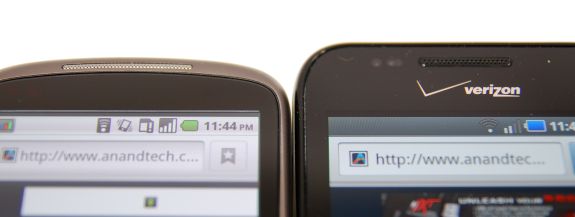
View this one bigger in full size to see what I mean
Next to the Nexus One, you can really see how much less distance there is between pixels and the surface of the top glass. The Samsung's Super AMOLED display literally appears to be on the surface.
The front of the Fascinate is one unbroken glass surface. Honestly, the display is probably the best part of the Fascinate. The 4" size isn't too big, but just right. At the bottom are capacitive buttons - as usual in yet a different order than I'm used to. Menu at the far left, home, back, then search from left to right.
The buttons are backlit, but only for a few seconds at a time. It's a bit frustrating, especially since right when you want them to be backlit most, they're inexplicably not lit.
I'd say AMOLED has come a long way since the Nexus One. My Nexus One routinely has ghosting and appears off-white - the Fascinate's Super AMOLED display is perfect. I used to be turned off by AMOLED's weird grain from the PenTile matrix - the Fascinate somehow has noticeably less. Either that, or I've just grown more accustomed to it. The oversaturation downside is still there, it's especially obvious when you pull screenshots from the Fascinate or any AMOLED device down to the desktop on a calibrated display.
Outside readability in practice is improved from the Nexus One. Honestly, it's still hard to read in direct sunlight outside, but it's better. For doing just about anything, seek shade.
Viewing angles on Super AMOLED are pretty awesome. I'd say contrast is pretty much unchanged even at extreme angles like 85 degrees. I've included lots of different angles and more outdoor and indoor comparison shots in the gallery below.
The oddest parts of the Fascinate's display are all the brightness settings. There are three of them - one in settings that every Android device has, another down below that's basically dynamic contrast, and one in the browser. It can get a bit confusing controlling everything that's going on brightness wise.
I measured a bit more brightness than Anand did on the Epic 4G:
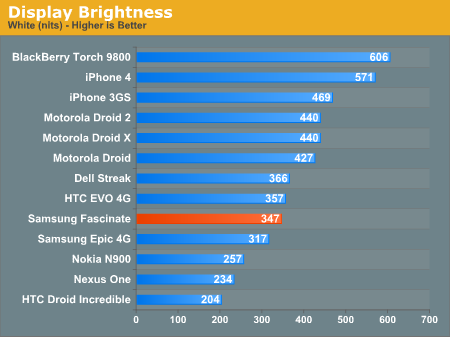

Black levels are perfect again, and thus so is contrast.
I have to agree with Anand - if resolution is what you care about, the iPhone 4 leads. If contrast and seriously vibrant (to the point of being oversaturated) colors are what you like, Super AMOLED is where it's at.


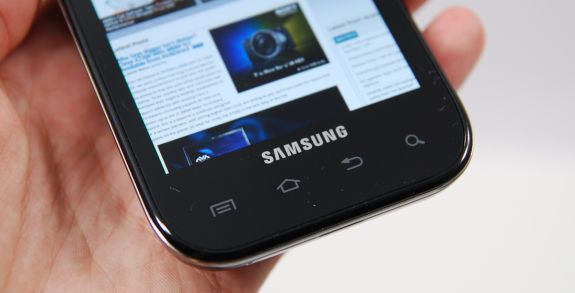
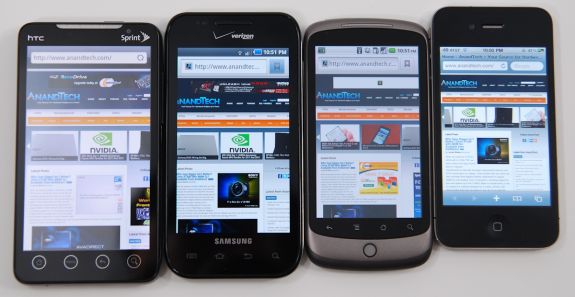
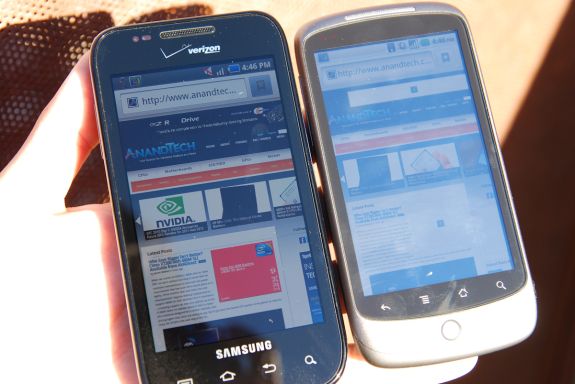














73 Comments
View All Comments
netmasterjohn - Tuesday, October 5, 2010 - link
How come Fascinate & Nexus One video are the same?dman - Tuesday, October 5, 2010 - link
I appreciate the testing methodology including the GPS fix times. I had an ATT Tilt (HTC 8925) which was notoriously slow in getting locked in. I got into the habit of starting the GPS app as soon as I'd get outdoors so that by the time I'd get to my vehicle it'd only have a couple minutes left. That and a few other workarounds. Sad that they still have issues these days...Chadder007 - Tuesday, October 5, 2010 - link
My Droid X came with a 16GB card, not 8.chemist1 - Tuesday, October 5, 2010 - link
Brian: Thanks for your reply. I'm pleased to hear you're trying to move in that direction. The idea of playing with CDMA voice codecs is intriguing -- I didn't occur to me that the audio quality (AQ) of smart phones could actually be user-modifiable at the software level. Though much of what determines AQ is hardware—the quality of the speaker in the earpiece, the circuitry upstream of it (and at the headphone jack output), the quality of the microphone (for those on the receiving end of your call), etc.More broadly, I like your general program of trying to put all areas that are now subjective onto a more objective footing. The problem with doing that for AQ is that it’s tricky. Often something can measure well, yet sound mediocre—which typically means that the measurements being used aren’t the right ones (for instance, maybe you’re measuring distortion, but the real problem is a phase error); or, alternately, perhaps the measurements aren’t being weighted properly. One solution is to supplement measurements with purely subjective, yet controlled, observations (a listening panel). You could also evaluate audio under compromised conditions by checking word recognition accuracy (but the danger here is that what might help accuracy under poor conditions—say, a boosted upper midrange—might make the phone fatiguingly harsh to listen to under normal conditions). Beyond that, I’d just reiterate what I said in my first post—I’d advise bringing in someone with a trained ear and/or lots of audio testing experience (if that's possible). [You can test for a trained ear by seeing if he/she can distinguish between different codecs in a single-blind test; or, alternately, perhaps you know, say, a recording engineer or a good classical pianist.]
Also, if you would, please ask Anand to read the Heijligers link I posted in my last comment, before he next tests iPods! [And you or he might wish to test the Redwine modification available for the 4G–5.5G iPods (http://redwineaudio.com/products/imod), to hear for yourselves what difference improved output circuitry can make in PMP AQ.]
Ranari - Tuesday, October 5, 2010 - link
*NOTE TO AUTHOR*Verizon and Microsoft have an advertising contract between each other, which is why you see Bing plastered all over the Samsung Fascinate. Businesses can control mobile ads in the Bing search engine using the Microsoft Adcenter. Mind you, this is over the Verizon network, but you can also see a few Bing mobile ads on m.bing.com, or if you download the Bing app on your smartphone. If you want a more Google experience, the other carriers will probably be your thing, but I find it to be more of an extension of the Android OS.
Personally, I think Bing has a pretty awesome mobile platform.
Aside from that, the review perfectly matches up with my thoughts about my Samsung Vibrant (T-Mobile).
-The Super AMOLED is absolutely gorgeous.
-The GPU is overkill, and I like it that way.
-Performance is great
-Battery life is mediocre
-And the GPS sucks bizalls
Cheers!
silverblue - Wednesday, October 6, 2010 - link
Sorry, didn't mean to be picky. :)anaxagoras1986 - Wednesday, October 6, 2010 - link
I'm not sure how the Galaxy is clearly better. It has a better GPU which is great, but only if you can use it. I don't play games so GPU performance is less important to me.Real-world performance with an Incredible (all of which are 2.2 now, why are you still testing or showing 2.1 results?) is close to the Nexus One 2.2 and HTC Evo 2,2. The charts show the 2.2 phones with a substantial performance advantage over the Galaxy.
So how is the Galaxy clearly better?
Doppleganger77 - Wednesday, October 6, 2010 - link
Even applying just the lag fix (fixes file system) to a 2.1 Galaxy S dramatically increases performance. For example, in the Quadrant benchmark I routinely achieve over 2200 points compared to about 800 for a standard Galaxy S. The Nexus One 2.2+ by comparison achieves around 1300 points. By applying a one click solution this phone can fly.ezinner - Thursday, October 7, 2010 - link
Arghh! I love the Galaxy S phones, but why oh why can't they put phone function buttons on the phone? Remember that this is still a phone and the most common functions are answer and end call!Jumpman23 - Saturday, October 9, 2010 - link
I always thought the iPhone ran at 1 GHz. So is 800MHz a typo or...